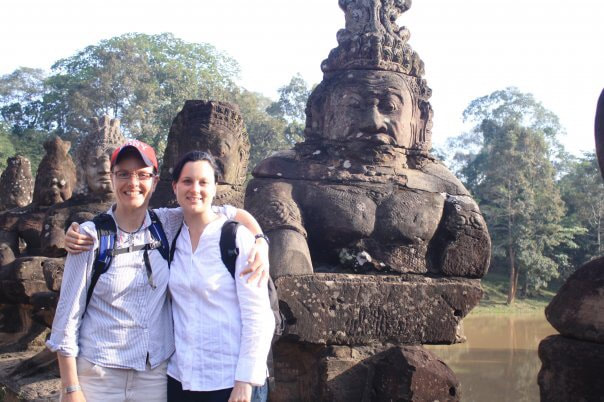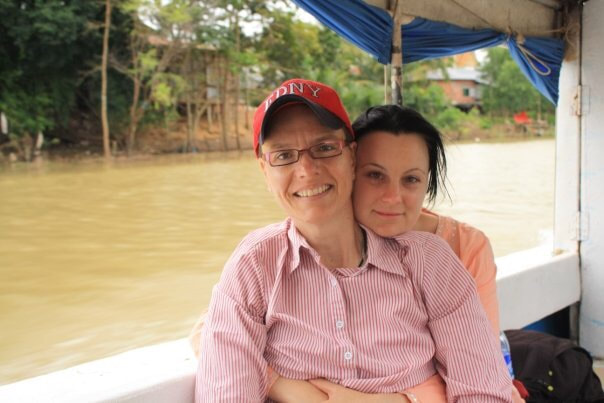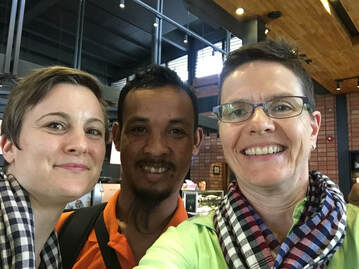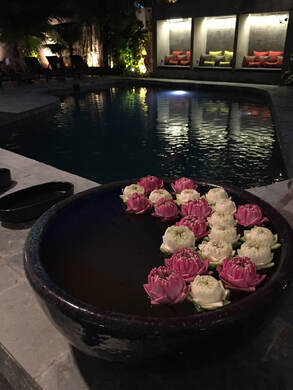Tales of Pacific Pride
|
We first came to Phnom Penh 10 years ago. It was our honeymoon, and Cambodia’s capital was the first stop on our 12-day Intrepid tour. November was hot, humid, & bustling. Jet-lagged, we headed straight out of our hotel with a few hours to kill before the welcome dinner. We soon discovered clear footpaths were a luxury not afforded most streets. If they did exist, they were turned over to sidewalk restaurants, mechanics workshops or moto parking lots.
We were an oddity, walking the length of the main street, waving away the constant refrain of, 'Hello, you want tuk tuk?' But we were instantly captivated by the steaming, chaotic city and its surprisingly relaxed inhabitants. There wasn’t much development then; a few shiny banks & less than a handful of high-end hotels. Fast forward to 2019 & the change is evident. As with Hanoi, the juxtaposition of old & new is stark. But now, the city that seemed frantic to us ten years ago feels different. The pace of life remains far less frenetic than Hanoi. This city, though busy, is more chilled. We meet with Dirk de Graaff, who owns the Rambutan with his partner Tum Hantitipart. We’re hoping to gain a Westerner’s tips on the gay scene here & to avoid any rookie mistakes, like the one we made ten years ago. (More on that later.) There's a divide between the city LBGTQI and the rural; the two rarely intersect. Dirk stresses that it's not a community in the sense that we know. We ask about gay bars, having noticed that Blue Chilli has been around since 2006. Most of the others sputter into life and close within two years, he tells us. Finding a lesbian bar is hard. We ask about The L Bar, opened in 2016 by two French women - closed. 'All I know about the lesbian scene is that they head off on motorbikes & go somewhere', says Dirk. ‘I saw a documentary about it once. I don’t know how it works.’ Sarah has a sheepish smile on her face; it’s time to fess up about our one and only attempt to find a lesbian bar in Cambodia, on our last night in Phnom Penh, all those years ago. At the mere mention of the Pussycat Bar, Dirk collapses in laughter. Seems we don’t have to explain all that much. Our tour guide of 2009 helpfully suggested a bar to us that he thought lesbians could go to. Pussycat Bar - it sounded cute. Somehow we managed to pick up a tuk tuk driver from our hotel who was clearly a screaming queen. ‘Pussycat Bar!’, he trilled, as we tucked ourselves in behind him. We’d dressed down for the evening, in our standard tourist guise of knee-length shorts and long-sleeved shirts. We’d made the mistake previously of dressing up to go to a gay bar in Siem Reap and found everyone was in t-shirts and jeans, so we figured the Cambodian scene was more relaxed. Our tuk tuk pulls up outside a narrow entranceway, lit with neon, the pavement in front crowded with moto and with some big guys dressed in leather. We head down the stairs to find more neon lighting a narrow bar, a large pool table, and about a dozen girls. They’re all young, they’re all gorgeous, with long, flowing hair, they’re all immaculately made-up, and they’re all wearing very short skirts. We like to think we don’t stereotype, but we’re pretty surprised at how different Khmer lesbians look to those we’ve met around the rest of the world. We sit at the bar, feeling seriously under-dressed, and look over the menu, trying to make bright conversation with the bartender. They don’t have most of the drinks listed on the menu. As we peruse it, we find a semicircle of girls closing in on us. One in particular seats herself next to Mel and starts asking questions - ‘Where are you from?’ We feel like somehow this cultural exchange isn’t panning out quite as we’d expect. The girls are looking at us expectantly. They seem to be much more interested in Mel than in Sarah, but it’s clear the ringleted lass doing most of the talking has adopted her, and the other girls slowly drop away as her pout deepens. They try and entice us off the bar stools, to which we are firmly rooted, to play pool. Mel, quite keen on pool from her days as a university chorister, isn't going anywhere, despite encouragement (from Sarah included, who knows her wife likes pool). Mel later confesses she wasn’t bending over a pool table for anybody. By this point we both think there’s definitely something going on we can’t fathom, finish our drinks and pay up. We thank the girls and depart. As we leave, the burly guys in black leather hustle for our business: ‘Moto?’ ‘Tuk tuk!’ shrieks our driver, waving his hands in the air and leading us across the road to his vehicle at a trot. On the way home, he tries to convince us to go to a drag show at Blue Chilli, but we’re done for the night. Back in our hotel room, Mel confesses she really needed the bathroom but was too scared to make a move. Sarah says the same, and we both shake our heads and laugh. It takes ten years for us to find out about ‘hostess bars’, and by that point, Dirk is laughing about as hard as we did. Oops.
2 Comments
Where to begin?
It’s evening of our first full day in Cambodia. Our heads are exploding with information; our hearts are already full with some of the stories we’ve heard. We’re glad to be back in this crazy-beautiful city after nearly 10 years, and back in the gay-owned Rambutan Resort, in whose sister hotel in Siem Reap we first thought about bringing a pride choir to Cambodia. We had our first meeting with an LGBTQI organisation, Cam-ASEAN, this afternoon, in the Starbucks at Bokor traffic lights (yes, they’re a landmark). The Starbucks is large, cool and clearly a popular meeting place. We’re meeting with activist Srun Srorn, who tells us one of his current projects is providing job opportunities for young LGBT people to prevent them from homelessness. Employers can sign up to receive CVs from young folk at risk once they’re proven to be able to provide a safe working environment. We’re at Starbucks Bokor because the boss there has signed up. We’ve ordered our coffees (‘two coffees for Miss Sarah’ calls the young barista) when Srorn and his colleague Pheung Sophea arrive, straight from another meeting. We know that Cam-ASEAN is responsible for the brand new SOGI curriculum (Sexual Orientation and Gender Identity) to be rolled out nationally for high school students as part of the Life Skills curriculum in 2019. We have lots of questions about it, particularly considering our own Australian government has just withdrawn Safe Schools, an equivalent program, from our own schools. But the story Srorn launches into about Cam-ASEAN’s current project is beyond incredible. Srorn tells us of his work to create the same recognition for lesbians and trans people at an official level as there is for gay Khmer. Several years ago, he faced the official position that there were hardly any lesbians or trans people in Cambodia; since then he has worked to help dispel that myth. Cam-ASEAN's recent work is to go into villages and connect with trans and lesbian couples. We ask how they identify these people, and are stunned by his response. Srorn and Sophea travelled from village to village, all over Cambodia. They asked the local police, the tuk tuk drivers, and the street sellers - people who know most of the village - 'Do you know any men who dress like women, or women who dress like men?’ ‘Yikes!’, Mel is thinking, 'Can you imagine that approach back home, where coming out is such a personal thing and we round on anybody who publicly 'outs' someone?’ Meanwhile, Sarah is impressed at the perseverance of such a painstaking approach to gathering information. It seems a direct approach works, and works well. For many couples, the old cliche of being ‘the only gay in the village’ was true. Yet in one village alone, 7 long-standing trans couples identified themselves and are part of the project. Many of these couples have been together for over 40 years and survived the Khmer Rouge regime (that, in itself, does our heads in). Outside their village community, all these couples have come to realise they are not alone. And likewise, so have their neighbours and families. Their stories are collected in a roving exhibition, ‘My Voice, My Story’. Just like Srorn and Sophea when collecting the stories, the exhibition now roams from village to village. Neighbours weep as they hear the stories of people who have been living among them all their lives. But the point of the project - of any of Srorn’s projects - isn’t to inspire pity for the difficulties of a queer life. It’s to empower LGBTQ people to show the strength in their lives. They have identified 5,000 people across Cambodia living in long-term (decades-long) trans and lesbian relationships. These elders were unknown to the young queer folk now centred on Cambodia’s big cities, or who have moved overseas. But now the faces of these elders are being seen, their stories are holding up the young folk, and, more importantly, they are stepping forward as key contributors to their own communities. Srorn shows us a video of a transman and his partner who are setting up a home for the old and poor in their community. It’s the same video we saw over breakfast this morning, reading up on Cam-ASEAN. This story was the tip of the iceberg in our 90-minute conversation. Srorn is a passionate activist. He’s not the type to stay with one organisation, resting on his laurels. He tell us that he founds groups and then, when they secure funding, he leaves to start something new in the next area he feels needs development. He and Cam-ASEAN also use a model in all their projects which trains people to speak for themselves; young LGBTQ folk on Facebook live are interviewed about their lives, and then become the interviewer for a queer friend in their circle in a subsequent episode. Similarly, trans men and women accompany the roving ‘My Voice, My Story’ exhibition to rural villages, give their stories in person, and in doing so, train up the trans people in that village to speak about themselves. Srorn has several ideas about how Pacific Pride Choir can support Khmer people. It will take time for us to figure out which one we can make work. Whatever it is, we reckon it’s going to be something that could teach the Australian government a thing or two about recognition. |
Mel & Sarah
Currently blogging from home, in iso like everyone else, and catching up with PPC19 in the form of a daily photojournal. Archives
June 2020
Categories
|
Proudly powered by Weebly




 RSS Feed
RSS Feed